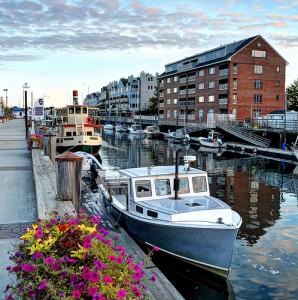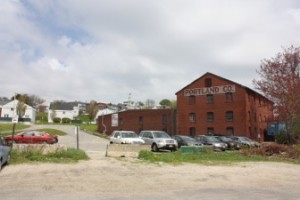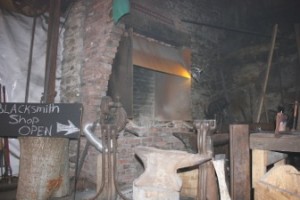Producing history and ironwork in an urban crucible (Part II)
04 September 2014 – David Rotenstein

Portland’s waterfront has been the site of considerable redevelopment in recent decades. Photo credit: Wendell
Continued from Part 1.
Portland’s gentrification and redevelopment attracted the attention of Loretta Lees, a United Kingdom professor with family in Maine. She documented the rehabilitation of residential, commercial, and industrial properties and the reconfiguration of public spaces in Portland’s upgrading downtown neighborhoods. New people, new capital, and new regulatory regimes aimed at protecting new investments collided in Portland’s streets and squares. Lees honed in on the city’s youth culture and its clash with business owners and city officials in competing to use adapted old spaces.
The Portland conflict Lees documented occurred in a global process that sanitizes and homogenizes urban spaces via socially engineered diversity initiatives. Since Portland isn’t New York or some other big city, its downtown gentrification provided Lees with an opportunity to observe urban conflict on a smaller scale. I have seen the same process at work in the control of space in revitalized downtown Silver Spring, Maryland, a Washington, DC, suburb where skateboarders and photographers came into conflict with county officials who had ceded control over public spaces to a private redevelopment company.
In its efforts to produce safe, clean, and attractive downtown spaces, Portland privileged the production of particular kinds of culture and consumption while marginalizing and outlawing others. Whether it is skateboarders appropriating urban plazas, buskers creating new soundscapes, or panhandlers, there are groups of people who appear in newly produced space who make others, the “desired” consumers of that space, feel uncomfortable and whom officials perceive as threats to urban investments.
I didn’t call it “gentrification,” but my work on blues tourism in Helena, Arkansas, documented the erasure of juke joints and other places where urban black culture was produced to create safe spaces for people to enjoy “authentic” Delta blues. I wrote how blues music helped spur reinvestment in a poor Delta city. “In an attempt to rehabilitate the ‘deteriorating’ downtown neighborhood and provide open spaces for festival visitors, the town has allowed to disappear much of the ‘local color’ that made Helena a blues city,” I wrote in a 1992 Southern Folklore article on Helena’s blues culture (Vol. 49, pp. 133-46).
Whether it is suburban Washington, the Mississippi Delta, or a small New England city, gentrification is a play for power. As Portland moves forward in implementing its master plan for the Eastern Waterfront zone, new spaces will be created with specific producers and consumers in mind. Public officials have articulated a vision for the zone in planning documents and the private sector will pony up the financial and human capital to implement the vision.

The Portland Company complex, shown in May 2014, is within a zone slated to be redeveloped. Photo credit: David S. Rotenstein
Permitted uses in the Eastern Waterfront zone include craft shops with onsite production. But blacksmith shops can be noisy, smoky, and they are considered nuisances and fire hazards in many cities. Because of the property’s sensitive setting along Portland’s historic working waterfront, developers will have to navigate a regulatory mazeway that includes rezoning and environmental issues. Incorporating the new uses–residential and commercial–into the site and the surrounding area undergoing redevelopment likely will involve displacement for existing businesses and residents.
Sam Smith fears that his blacksmith shop located beneath pricey new condominiums might be considered a nuisance. “How many people want a blacksmith shop in their basement? Maybe me or you,” Smith said.
Since the property sale last year, Smith has been in negotiations with the new owners to remain in his space. “Ultimately the shop is in limbo and I’ve had some talks with the owners saying that they want to keep it as an artistic studio but they never came out and said yes, we’re going to keep it as a traditional blacksmith shop,” Smith explained. “Because that’s my greatest concern since I make my livelihood because I’m a traditional blacksmith.”
Alternatives to closing the business include relocation to another site elsewhere in the city. The situation has kept Smith from investing in his space. His current layout includes several antique English anvils and a side-tuyere forge that gets air from mechanical blowers. Smith wants to install a pair of large traditional leather bellows. It would be a significant investment and the looming redevelopment and uncertainty are influencing his decisionmaking. “I told them I would need at least a fifteen-year lease before I would be willing to sacrifice those kinds of funds for a building I don’t even own,” Smith said.
Smith’s plight is similar to other small-scale industrial or craft enterprises established in struggling neighborhoods targeted for redevelopment. Industrial displacement is like residential displacement: it is forced dislocation. About industrial displacement in New York City, Winifred Curran wrote it is “the result of speculative real estate pressure that is tied directly to gentrification.” Smith has a simpler answer: “I don’t know if I can attribute it to gentrification. I can attribute the threats to my shop mainly from greed.”
Ethnographer Michael Herzfeld eloquently chronicled the externalities associated with industrial displacement in Evicted from Eternity: The Restructuring of Modern Rome (University of Chicago Press, 2009). Herzfeld described craftspeople as “the economic backbone” in the neighborhood where he did his fieldwork. As demand for new housing and new businesses to serve more upscale residents increased in Rome’s Monti neighborhood, artisans found themselves priced and regulated out of business.
Sam Smith’s small shop is caught in a global pattern of uneven development, and it could succumb to competing definitions of diversity, desirability, sustainability, and economic viability. The Portland Forge is an active part of the local and regional economy. It produces architectural iron and other objects for new, wealthier households repopulating Portland’s neighborhoods. And it is a destination for students and tourists drawn to what seems to onlookers to be an urban anachronism, a working blacksmith shop. For now, Smith’s shop is economically and environmentally sustainable. Will it continue to be sustainable and viable as the neighborhood continues to gentrify or will Smith be replaced by jewelry makers, potters, or a craft brewer? Will Smith’s shop survive? Only time will tell.
~David Rotenstein (Historian for Hire) is an independent consultant working in Atlanta, Washington, DC, and beyond.
Notes
The Society for Industrial Archeology held its 2014 annual meeting in Portland. I met Smith on that trip and I briefly spoke with him in his shop. The week after the conference, I interviewed Smith by phone.
Further reading on gentrification in Portland:
- Bauman, John F. “A Saga of Renewal in a Maine City: Exploring the Fate of Portland’s Bayside District.” Journal of Planning History 5, no. 4 (November 1, 2006): 329–54.
- Lees, Loretta. “The Ambivalence of Diversity and the Politics of Urban Renaissance: The Case of Youth in Downtown Portland, Maine, USA.” International Journal of Urban and Regional Research 1 (2007).
- Hot Sauce and High Tops. “Urban Renewal in Portland, Maine: Gentrification in Disguise.” Hot Sauce and High Tops, December 25, 2008.





1 comment